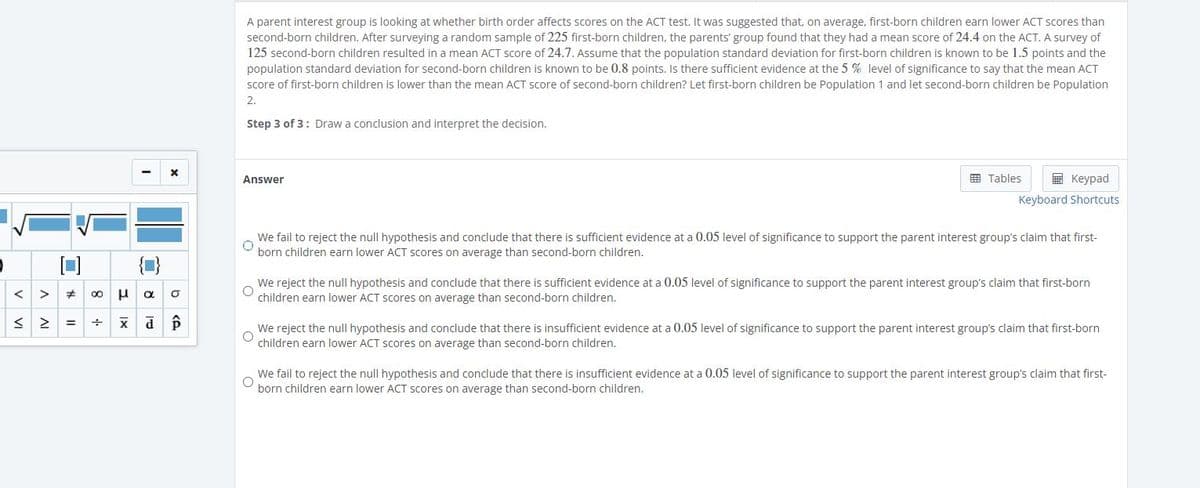Step 3 of 3: Draw a conclusion and interpret the decision. Answer Tables E Keypad Keyboard Shortcuts We fail to reject the null hypothesis and concdude that there is sufficient evidence at a 0.05 level of significance to support the parent interest group's claim that first- born children earn lower ACT scores on average than second-born children. We reject the null hypothesis and conclude that there is sufficient evidence at a 0.05 level of significance to support the parent interest group's claim that first-born children earn lower ACT scores on average than second-born children. We reject the null hypothesis and conclude that there is insufficient evidence at a 0.05 level of significance to support the parent interest group's claim that first-born children earn lower ACT scores on average than second-born children. We fail to reject the null hypothesis and conclude that there is insufficient evidence at a 0.05 level of significance to support the parent interest group's claim that first- born children earn lower ACT scores on average than second-born children.
Step 3 of 3: Draw a conclusion and interpret the decision. Answer Tables E Keypad Keyboard Shortcuts We fail to reject the null hypothesis and concdude that there is sufficient evidence at a 0.05 level of significance to support the parent interest group's claim that first- born children earn lower ACT scores on average than second-born children. We reject the null hypothesis and conclude that there is sufficient evidence at a 0.05 level of significance to support the parent interest group's claim that first-born children earn lower ACT scores on average than second-born children. We reject the null hypothesis and conclude that there is insufficient evidence at a 0.05 level of significance to support the parent interest group's claim that first-born children earn lower ACT scores on average than second-born children. We fail to reject the null hypothesis and conclude that there is insufficient evidence at a 0.05 level of significance to support the parent interest group's claim that first- born children earn lower ACT scores on average than second-born children.
Glencoe Algebra 1, Student Edition, 9780079039897, 0079039898, 2018
18th Edition
ISBN:9780079039897
Author:Carter
Publisher:Carter
Chapter10: Statistics
Section10.4: Distributions Of Data
Problem 19PFA
Related questions
Question

Transcribed Image Text:A parent interest group is looking at whether birth order affects scores on the ACT test. It was suggested that, on average, first-born children earn lower ACT scores than
second-born children. After surveying a random sample of 225 first-born children, the parents' group found that they had a mean score of 24.4 on the ACT. A survey of
125 second-born children resulted in a mean ACT score of 24.7. Assume that the population standard deviation for first-born children is known to be 1.5 points and the
population standard deviation for second-born children is known to be 0.8 points. Is there sufficient evidence at the 5 % level of significance to say that the mean ACT
score of first-born children is lower than the mean ACT score of second-born children? Let first-born children be Population 1 and let second-born children be Population
2.
Step 3 of 3: Draw a conclusion and interpret the decision.
Answer
E Tables
E Keypad
Keyboard Shortcuts
We fail to reject the null hypothesis and conclude that there is sufficient evidence at a 0.05 level of significance to support the parent interest group's claim that first-
born children earn lower ACT scores on average than second-born children.
{1}
We reject the null hypothesis and conclude that there is sufficient evidence at a 0.05 level of significance to support the parent interest group's claim that first-born
children earn lower ACT scores on average than second-born children.
We reject the null hypothesis and conclude that there is insufficient evidence at a 0.05 level of significance to support the parent interest group's claim that first-born
children earn lower ACT scores on average than second-born children.
We fail to reject the null hypothesis and conclude that there is insufficient evidence at a 0.05 level of significance to support the parent interest group's claim that first-
born children earn lower ACT scores on average than second-born children.
b
V
Expert Solution
This question has been solved!
Explore an expertly crafted, step-by-step solution for a thorough understanding of key concepts.
Step by step
Solved in 2 steps with 1 images

Recommended textbooks for you

Glencoe Algebra 1, Student Edition, 9780079039897…
Algebra
ISBN:
9780079039897
Author:
Carter
Publisher:
McGraw Hill

Glencoe Algebra 1, Student Edition, 9780079039897…
Algebra
ISBN:
9780079039897
Author:
Carter
Publisher:
McGraw Hill